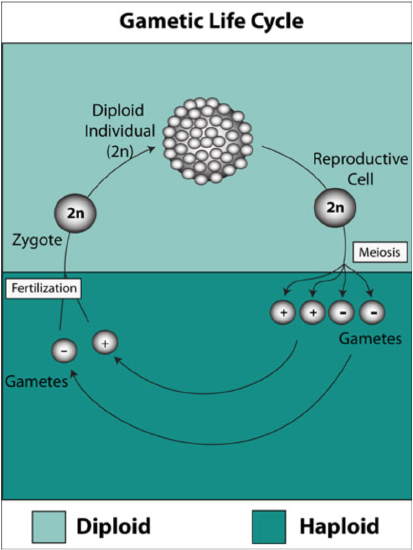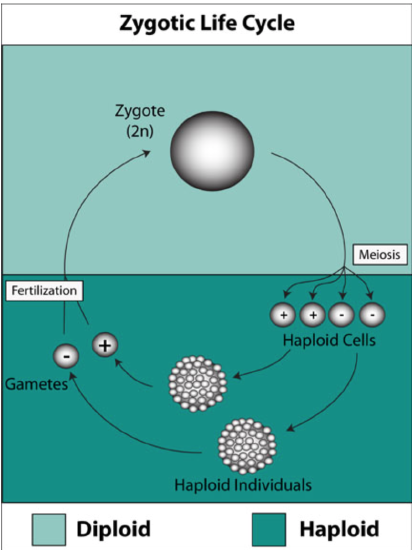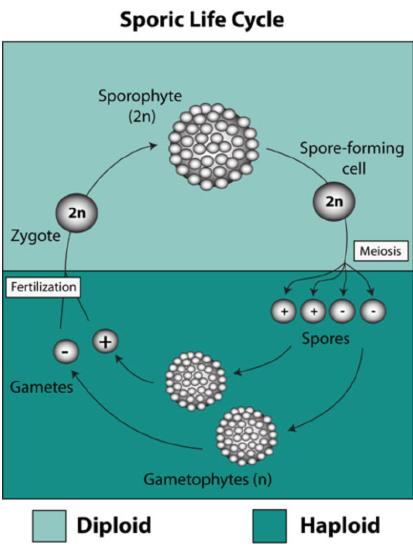Eukaryotic Life Cycles
- Page ID
- 24000
\( \newcommand{\vecs}[1]{\overset { \scriptstyle \rightharpoonup} {\mathbf{#1}} } \)
\( \newcommand{\vecd}[1]{\overset{-\!-\!\rightharpoonup}{\vphantom{a}\smash {#1}}} \)
\( \newcommand{\dsum}{\displaystyle\sum\limits} \)
\( \newcommand{\dint}{\displaystyle\int\limits} \)
\( \newcommand{\dlim}{\displaystyle\lim\limits} \)
\( \newcommand{\id}{\mathrm{id}}\) \( \newcommand{\Span}{\mathrm{span}}\)
( \newcommand{\kernel}{\mathrm{null}\,}\) \( \newcommand{\range}{\mathrm{range}\,}\)
\( \newcommand{\RealPart}{\mathrm{Re}}\) \( \newcommand{\ImaginaryPart}{\mathrm{Im}}\)
\( \newcommand{\Argument}{\mathrm{Arg}}\) \( \newcommand{\norm}[1]{\| #1 \|}\)
\( \newcommand{\inner}[2]{\langle #1, #2 \rangle}\)
\( \newcommand{\Span}{\mathrm{span}}\)
\( \newcommand{\id}{\mathrm{id}}\)
\( \newcommand{\Span}{\mathrm{span}}\)
\( \newcommand{\kernel}{\mathrm{null}\,}\)
\( \newcommand{\range}{\mathrm{range}\,}\)
\( \newcommand{\RealPart}{\mathrm{Re}}\)
\( \newcommand{\ImaginaryPart}{\mathrm{Im}}\)
\( \newcommand{\Argument}{\mathrm{Arg}}\)
\( \newcommand{\norm}[1]{\| #1 \|}\)
\( \newcommand{\inner}[2]{\langle #1, #2 \rangle}\)
\( \newcommand{\Span}{\mathrm{span}}\) \( \newcommand{\AA}{\unicode[.8,0]{x212B}}\)
\( \newcommand{\vectorA}[1]{\vec{#1}} % arrow\)
\( \newcommand{\vectorAt}[1]{\vec{\text{#1}}} % arrow\)
\( \newcommand{\vectorB}[1]{\overset { \scriptstyle \rightharpoonup} {\mathbf{#1}} } \)
\( \newcommand{\vectorC}[1]{\textbf{#1}} \)
\( \newcommand{\vectorD}[1]{\overrightarrow{#1}} \)
\( \newcommand{\vectorDt}[1]{\overrightarrow{\text{#1}}} \)
\( \newcommand{\vectE}[1]{\overset{-\!-\!\rightharpoonup}{\vphantom{a}\smash{\mathbf {#1}}}} \)
\( \newcommand{\vecs}[1]{\overset { \scriptstyle \rightharpoonup} {\mathbf{#1}} } \)
\( \newcommand{\vecd}[1]{\overset{-\!-\!\rightharpoonup}{\vphantom{a}\smash {#1}}} \)
\(\newcommand{\avec}{\mathbf a}\) \(\newcommand{\bvec}{\mathbf b}\) \(\newcommand{\cvec}{\mathbf c}\) \(\newcommand{\dvec}{\mathbf d}\) \(\newcommand{\dtil}{\widetilde{\mathbf d}}\) \(\newcommand{\evec}{\mathbf e}\) \(\newcommand{\fvec}{\mathbf f}\) \(\newcommand{\nvec}{\mathbf n}\) \(\newcommand{\pvec}{\mathbf p}\) \(\newcommand{\qvec}{\mathbf q}\) \(\newcommand{\svec}{\mathbf s}\) \(\newcommand{\tvec}{\mathbf t}\) \(\newcommand{\uvec}{\mathbf u}\) \(\newcommand{\vvec}{\mathbf v}\) \(\newcommand{\wvec}{\mathbf w}\) \(\newcommand{\xvec}{\mathbf x}\) \(\newcommand{\yvec}{\mathbf y}\) \(\newcommand{\zvec}{\mathbf z}\) \(\newcommand{\rvec}{\mathbf r}\) \(\newcommand{\mvec}{\mathbf m}\) \(\newcommand{\zerovec}{\mathbf 0}\) \(\newcommand{\onevec}{\mathbf 1}\) \(\newcommand{\real}{\mathbb R}\) \(\newcommand{\twovec}[2]{\left[\begin{array}{r}#1 \\ #2 \end{array}\right]}\) \(\newcommand{\ctwovec}[2]{\left[\begin{array}{c}#1 \\ #2 \end{array}\right]}\) \(\newcommand{\threevec}[3]{\left[\begin{array}{r}#1 \\ #2 \\ #3 \end{array}\right]}\) \(\newcommand{\cthreevec}[3]{\left[\begin{array}{c}#1 \\ #2 \\ #3 \end{array}\right]}\) \(\newcommand{\fourvec}[4]{\left[\begin{array}{r}#1 \\ #2 \\ #3 \\ #4 \end{array}\right]}\) \(\newcommand{\cfourvec}[4]{\left[\begin{array}{c}#1 \\ #2 \\ #3 \\ #4 \end{array}\right]}\) \(\newcommand{\fivevec}[5]{\left[\begin{array}{r}#1 \\ #2 \\ #3 \\ #4 \\ #5 \\ \end{array}\right]}\) \(\newcommand{\cfivevec}[5]{\left[\begin{array}{c}#1 \\ #2 \\ #3 \\ #4 \\ #5 \\ \end{array}\right]}\) \(\newcommand{\mattwo}[4]{\left[\begin{array}{rr}#1 \amp #2 \\ #3 \amp #4 \\ \end{array}\right]}\) \(\newcommand{\laspan}[1]{\text{Span}\{#1\}}\) \(\newcommand{\bcal}{\cal B}\) \(\newcommand{\ccal}{\cal C}\) \(\newcommand{\scal}{\cal S}\) \(\newcommand{\wcal}{\cal W}\) \(\newcommand{\ecal}{\cal E}\) \(\newcommand{\coords}[2]{\left\{#1\right\}_{#2}}\) \(\newcommand{\gray}[1]{\color{gray}{#1}}\) \(\newcommand{\lgray}[1]{\color{lightgray}{#1}}\) \(\newcommand{\rank}{\operatorname{rank}}\) \(\newcommand{\row}{\text{Row}}\) \(\newcommand{\col}{\text{Col}}\) \(\renewcommand{\row}{\text{Row}}\) \(\newcommand{\nul}{\text{Nul}}\) \(\newcommand{\var}{\text{Var}}\) \(\newcommand{\corr}{\text{corr}}\) \(\newcommand{\len}[1]{\left|#1\right|}\) \(\newcommand{\bbar}{\overline{\bvec}}\) \(\newcommand{\bhat}{\widehat{\bvec}}\) \(\newcommand{\bperp}{\bvec^\perp}\) \(\newcommand{\xhat}{\widehat{\xvec}}\) \(\newcommand{\vhat}{\widehat{\vvec}}\) \(\newcommand{\uhat}{\widehat{\uvec}}\) \(\newcommand{\what}{\widehat{\wvec}}\) \(\newcommand{\Sighat}{\widehat{\Sigma}}\) \(\newcommand{\lt}{<}\) \(\newcommand{\gt}{>}\) \(\newcommand{\amp}{&}\) \(\definecolor{fillinmathshade}{gray}{0.9}\)1. Description of Eukaryotic Life Cycles
In Biology, a life cycle (or life history) describes the course of development of an organism. A life cycle is the entire history of an organism, usually shown through a series of developmental stages that depicts the changes a species goes through as they pass from the start of a given developmental stage to the inception of the same developmental stage in the next generation.
The key differences between eukaryotic life cycles is the amount of time spent in haploid vs. diploid phases and the meiotic products (spores vs. gametes) that are produced. Recall that haploid cells contain only one set of chromosomes (n). Diploid cells contain two sets of chromosomes (2n). Meiosis is the process by which diploid cells divide twice in a row after replicating their chromosomes only once. The result is that each final daughter cell is haploid and contains only one copy of each chromosome. This differs from mitosis, when cells divide but the number of chromosome sets stays the same. In mitosis, haploid cells divide to form haploid cells and diploid cells divide to form diploid cells.
Diploid cells contain 2 copies of their genome, they typically:
1. Provide genetic redundancy which can increase resistance to DNA damage (there is a "back-up" copy of DNA in the event that one gets damaged).
2. Benefit from genetic exchange with other individuals, which can potentially provide more genetic diversity and thus offers a greater potential for survival in a changing environment.
3. Have slower growth because they have a longer cell cycle due to a greater amount of DNA to be replicated with each cell division.
Since haploid cells have only one copy of their genome they are typically:
1. More vulnerable to genetic damage (no "back-up" copy of DNA).
2. Able to grow faster since they don't have as much DNA to replicate with each cell cycle.
3. Able to combine with other haploid cells via fertilization.
In addition to cell division, another key stage in each life cycle is fertilization, or the fusion of two cells, which results in the formation of a diploid cell, the zygote.
We will now review the three major types of Eukaryotic life cycles (sporic, zygotic and gametic) in more detail.
Gametic Life Cycle
The gametic life cycle is the reproductive cycle found in animals and some protistans. The term gametic refers to the fact that gametes are the result of meiosis.
During the gametic life cycle a reproductive cell produces haploid gametes (sex cells such as egg and sperm) that combine to produce a zygote. The zygote grows by cell division and cell elongation to produce a multicellular diploid individual. In the gametic life cycle, the gametes are the only haploid stage found in the life cycle. The gametes (egg and sperm) are the only haploid cells produced.

Figure \(\PageIndex{1}\). (CC BY-NC-SA)
Zygotic Life Cycle
The zygotic life cycle is the simplest sexual life cycle, common among fungi and protists. These organisms are haploid during most of their life cycle.
In the zygotic life cycle, the zygote is the only diploid phase. After fertilization the zygote undergoes meiosis to produce haploid cells. The cells undergo mitosis to either increase in number or grow into a haploid multicellular organism. Some haploid cells develop into gametes by mitosis.

Figure \(\PageIndex{2}\). (CC BY-NC-SA)
Sporic Life Cycle
The sporic life cycle is common algae and plants. The term sporic refers to the fact that spores are the result of meiosis.
The sporic life cycle results from an alternation between a haploid and a diploid organism. Because of this, sometimes this cycle is referred to as the "alternation of generations". The diploid zygote first replicates by a series of mitotic divisions to form a multicellular diploid organism, known as a sporophyte. The sporophyte undergoes meiosis and produces haploid spores. These spores germinate and differentiate into haploid multicellular individuals known as gametophytes. The gametophyte produces eggs and sperm by mitosis. The zygote that results from syngamy of the gametes grows into the sporophyte by repeated mitotic divisions and the cycle continues.

Figure \(\PageIndex{3}\). (CC BY-NC-SA)

Eukaryotic Life Cycles Tutorial by Dr. Katherine Harris is licensed under a Creative Commons Attribution-NonCommercial-ShareAlike 3.0 Unported License.
Funded by the U.S. Department of Education, Developing Hispanic Serving Institutions Program, #P031S090007.


